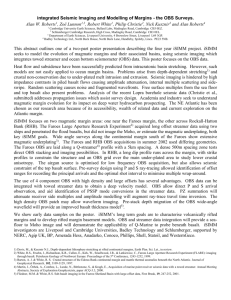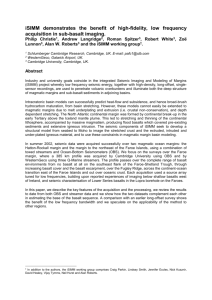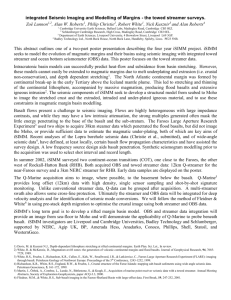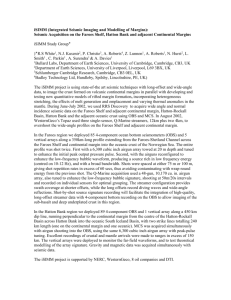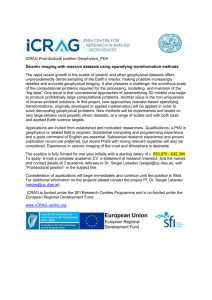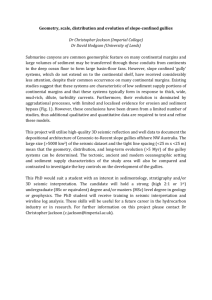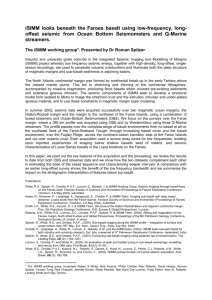christie_poster_abs
advertisement
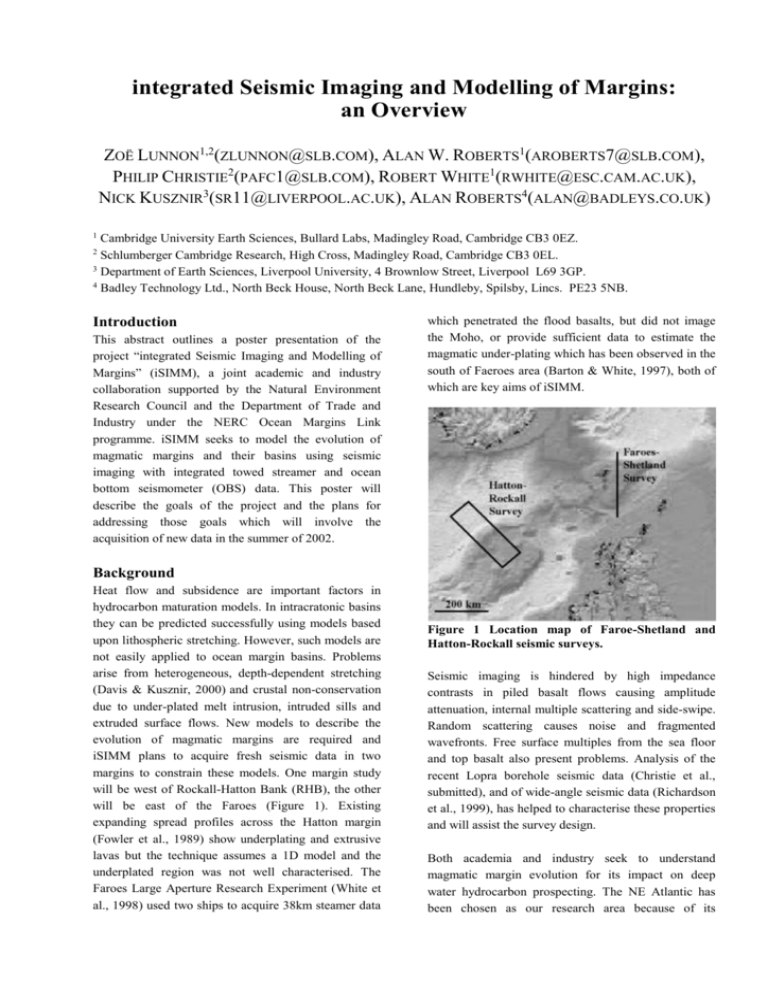
integrated Seismic Imaging and Modelling of Margins: an Overview ZOË LUNNON1,2(ZLUNNON@SLB.COM), ALAN W. ROBERTS1(AROBERTS7@SLB.COM), PHILIP CHRISTIE2(PAFC1@SLB.COM), ROBERT WHITE1(RWHITE@ESC.CAM.AC.UK), NICK KUSZNIR3(SR11@LIVERPOOL.AC.UK), ALAN ROBERTS4(ALAN@BADLEYS.CO.UK) 1 Cambridge University Earth Sciences, Bullard Labs, Madingley Road, Cambridge CB3 0EZ. Schlumberger Cambridge Research, High Cross, Madingley Road, Cambridge CB3 0EL. 3 Department of Earth Sciences, Liverpool University, 4 Brownlow Street, Liverpool L69 3GP. 4 Badley Technology Ltd., North Beck House, North Beck Lane, Hundleby, Spilsby, Lincs. PE23 5NB. 2 Introduction This abstract outlines a poster presentation of the project “integrated Seismic Imaging and Modelling of Margins” (iSIMM), a joint academic and industry collaboration supported by the Natural Environment Research Council and the Department of Trade and Industry under the NERC Ocean Margins Link programme. iSIMM seeks to model the evolution of magmatic margins and their basins using seismic imaging with integrated towed streamer and ocean bottom seismometer (OBS) data. This poster will describe the goals of the project and the plans for addressing those goals which will involve the acquisition of new data in the summer of 2002. which penetrated the flood basalts, but did not image the Moho, or provide sufficient data to estimate the magmatic under-plating which has been observed in the south of Faeroes area (Barton & White, 1997), both of which are key aims of iSIMM. Background Heat flow and subsidence are important factors in hydrocarbon maturation models. In intracratonic basins they can be predicted successfully using models based upon lithospheric stretching. However, such models are not easily applied to ocean margin basins. Problems arise from heterogeneous, depth-dependent stretching (Davis & Kusznir, 2000) and crustal non-conservation due to under-plated melt intrusion, intruded sills and extruded surface flows. New models to describe the evolution of magmatic margins are required and iSIMM plans to acquire fresh seismic data in two margins to constrain these models. One margin study will be west of Rockall-Hatton Bank (RHB), the other will be east of the Faroes (Figure 1). Existing expanding spread profiles across the Hatton margin (Fowler et al., 1989) show underplating and extrusive lavas but the technique assumes a 1D model and the underplated region was not well characterised. The Faroes Large Aperture Research Experiment (White et al., 1998) used two ships to acquire 38km steamer data Figure 1 Location map of Faroe-Shetland and Hatton-Rockall seismic surveys. Seismic imaging is hindered by high impedance contrasts in piled basalt flows causing amplitude attenuation, internal multiple scattering and side-swipe. Random scattering causes noise and fragmented wavefronts. Free surface multiples from the sea floor and top basalt also present problems. Analysis of the recent Lopra borehole seismic data (Christie et al., submitted), and of wide-angle seismic data (Richardson et al., 1999), has helped to characterise these properties and will assist the survey design. Both academia and industry seek to understand magmatic margin evolution for its impact on deep water hydrocarbon prospecting. The NE Atlantic has been chosen as our research area because of its accessibility, wealth of related data and the current exploration interest on the Atlantic margin. plan to follow Fleidner & White’s (2001) pre-stack depth migration to optimise the crustal image. Summary Planned data acquisition In summer 2002, iSIMM will survey the two continentocean transitions (COT). Both surveys will acquire Ocean Bottom Seismometer (OBS) data and towed streamer data in a two-vessel experiment using ship time supplied by NERC and WesternGeco. The NERC vessel will carry up to 100 OBS which will be deployed and recovered in both the survey areas in a 45 day operation. The NERC vessel will also acquire reflection seismic data using a 3km towed streamer shot over the OBS line in RHB. Faroes survey: the Faroes profile will run from known, basalt-free geology in the south, across thickening basalt to the north and cross the COT east of the Faroes. It will use OBS for wide-angle imaging at approximately 5km spacing. A dense 500m spacing zone will test direct OBS stacking and imaging possibilities. Reflection seismic will be acquired over the same profile with WesternGeco’s 12km Q streamer. The Q-Marine acquisition aims to image the crust from the seabed to the basement using a source array tuned for penetration. Q-Marine (Martin et al. 2000) provides long offset (12km) data with high density, single sensor sampling and shot-by-shot signature monitoring. Unlike conventional streamer data, Q-data can be grouped after acquisition offering full processing flexibility. A multi-streamer swath will be acquired, using steerable birds for accurate cross-line positioning, which will afford a certain amount of cross-line protection. RHB survey: in RHB, a long dip profile will run across the margin, with strike profiles to constrain the structure. An OBS grid over the main under-plated area will target lower crustal anisotropy. The source array will be optimised for low frequency OBS acquisition, but will also allow reflection seismic constraint of the sediments down to the top basalt surface, using the NERC 3km streamer. Synthetic seismogram modelling prior to the acquisition will be used to optimise the shot interval and record length. Ultimately the streamer and OBS data from each survey area will be integrated for velocity analysis, imaging and identification of seismic mode conversions. We iSIMM is a significant collaboration between industry and academia who share common research goals and who bring together complementary technologies. The long term objective of a model for magmatic margin evolution requires seismic characterisation of such margins which, if successful, will also be of benefit to the industry in sub-basalt exploration. The iSIMM investigators are Liverpool and Cambridge Universities, Badley Technology and Schlumberger Cambridge Research, supported by Agip UK, BP, Amerada Hess, Anadarko, Conoco, Phillips, Shell, Statoil, and WesternGeco. References Barton, A. J. & White, R. S., 1997, Crustal structure of the Edoras Bank continental margin and mantle thermal anomalies beneath the North Atlantic, Journal of Geophysical Research, 102, 3109-3129. Davis, M. & Kusznir N.J., 2000, Depth-dependent lithosphere stretching at rifted continental margins, Earth Plan. Sci. Let., in review. Fliedner, M.M. & White, R.S., 2001, Sub-basalt imaging in the Faeroe-Shetland Basin with largeoffset data, First Break, 19, 247-258. Fowler, S. R., White, R. S., Spence, G. D., Westbrook, G. K., 1989, The Hatton Bank continental margin: II Deep structure from two-ship expanding spread seismic profiles, Geophysical Journal, 96, 295-309. Martin, J., Özbek, A., Combee, L., Lunde, N., Bittlestone, S., & Kragh, E., 2000, Acquisition of marine point receiver seismic data with a towed streamer, Annual Meeting Abstracts, Society of Exploration Geophysicists, paper RC7.6. Richardson, K.R., White, R.S., England, R.W., & Fruehn, J., 1999, Crustal structure of the Faroe Islands: mapping sub-basalt sediments using wide angle seismic data, Petroleum Geoscience, 5, 161172. White, R. S., Fruehn, J., Richardson, K. R., Cullen, E., Kirk, W., Smallwood, J. R. & Latkiewicz, C. 1999, Faeroes Large Aperture Research Experiment (FLARE): Imaging through basalts, in Fleet, A. J. & Boldy, S. A. R. (eds.), Petroleum Geology of Northwest Europe: Proceedings of the 5th Conference, Geological Society of London, 12431252.
